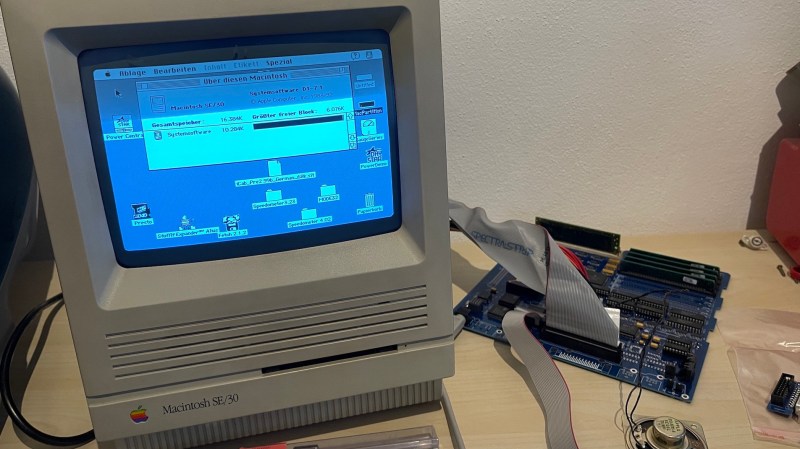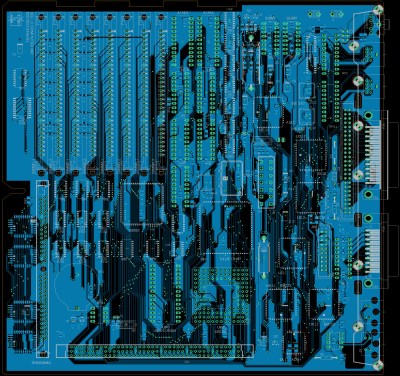Some time ago, [Bolle] got the idea to redraw the Macintosh SE/30 schematics in Eagle. Progress was initially slow, but over the past month (and with some prodding and assistance from fellow forum frequenter [GeekDot]), he’s taken things a step further by creating a fully functional replacement Macintosh SE/30 logic board PCB.
By using the available schematics, the project didn’t even require much reverse engineering. Though he plans for more modernization in later iterations, this design is largely faithful to the original components and layout, ensuring that it is at least basically functional. He did update the real time clock battery to a CR2032 and, as a benefit of redrawing all the traces, he was able to use a 4-layer PCB in place of the costly 6-layer from Apple’s design.
The board came back from fabrication looking beautiful in blue; and, once he had it soldered up and plugged in, the old Mac booted on the very first try! A copy-paste mistake with the SCSI footprints led to some jumper wire bodging in order to get the hard drive working, but that problem has already been fixed in the next revision. And, otherwise, he’s seen no differences from the original after a few hours of runtime.
Recreating old Macintosh logic boards almost seems like its own hobby these days. With the design and fabrication capabilities now accessible to hobbyists, even projects that were once considered professional work are in reach. If you’re interested in making your own PCB designs, there are many resources available to help you get started. Alternatively, we have seen other ways to modernize your classic Macs.
[Thanks to techknight for the tip!]

















Same RTC?
Does it handle Year >= 2000?
IIRC, Macs didn’t have a Y2K issue, even the old world Macs.
Some older Macs did have issues with 2020. If you tried to set the date past 2019, it rolls over 1904 for some reason. And my 660AV had a tantrum whenever the date is set to correct time so I am forced to leave it at the wrong year. There are software fix but that requires internet access and I don’t have an easy way of getting that.
That is a software problem, the control panel code is erroneous. With 3rd party tools you can change the date no problem (e.g. SetDate)
They were Y2K compliant. Now the year 29,940 is gonna be a problem for em.
I stand to correct myself, 29,940 applies to Power Macs. But previous Macintosh models have a year 2040 issue. Right around the corner compared to 29,940. But appears to be an OS issue and not a ROM issue. Can’t say I am concerned enough to dive any deeper.
Actually I believe it’ll be a problem much sooner–year 2040, in fact. While MacOS date calculation routines support 30,081 B.C. to 29,940 A.D., I believe the hardware clock and time-of-day MacOS routines only work up to 2040 A.D.
I don’t recall having Y2K issues with any of the several Macs I had at the time.
They didn’t not have a Y2K issue, but the old ones, pre-OS8, have a (fixable) issue with the year 2020 and, as far as I recall, all versions prior to OS X have unfixable one that will show up in about 2040.
I’ve read that UNIX systems had a 2038 limitation. That’s from a 32 bit second counter, which when it overflowed would be interpreted as 1904.
Looks like I’m wrong. The limit is 2034; the 32 bit counter rolls around to 1900. That makes more sense.
32-bit time_ts on unix systems store a signed number of seconds since 1970 January 1, which works out to 68 years and a couple weeks before and after.
But I have no idea what encoding leads to the 60020-year epoch of the PowerMacs… it’s close to a counting at 10MHz, but the span (30081 to 29940, supposedly) is just a little too long for 2**64 ÷ 10**7.
Unix used a signed 32-bit int with the start of the epoch at Jan 01 1970. The original Mac used an unsigned 32-bit int with the start of the epoch being Jan 1904 (supposedly the oldest living grandparent of the designteam was born in that year) so while Unix has a problem with 2038, the Macs have a problem with 2040.
Does the software using that RTC ?
I think I would check the current draw on the RTC battery, it may kill a 2032 faster than one might think. The original larger cells didnt have a significantly longer battery lifer than modern machines with a 2032.
My SE still had its soldered-in Varta, and it still held time and settings when I snipped it out recently. So anything is possible here.
I had one of those Varta batteries still backing up memory 15 years later in a 1980’s music synth after the first time I replaced it. As I recall, the voltage was still 3.1 something upon removal (worrying about leaking).
Many of the 3V coin cells available in the 1980s were lithium iodide. Lithium, iodine, and lithium iodide are all solids; The batteries had no fluids that could ever leak.
The Vartas are not coin cells, and the absolutely leak everywhere.
Interesting. How do these systems count time? Year 29,940 sounds very random to me..
Makes me wonder if he is selling this as a complete kit. I bet there are several interested in purchasing and hand-soldering this :)
In other words: How much? :D
Why not a modern ARM board or even a RISC-V board. Add SATA, WIFI, bluetooth and a decent sound chip would be do-able too. An opportunity missed, methinks
I’ll take a “missing the point” for $500 please
Because those won’t run the same software.
You hear that “wooosh” sound ? It was the point of this article flying right over your head.
this whole “woosh” thing is extremely rude. it suffices to remind the commentor that the point was replacing only the PCB of the SE30, not making an entirely new computer which fits inside of an SE30 case.
it isn’t mentioned in the hackaday summary, but doing this is valuable for keeping vintage electronics going if/when they need recapping, or suffer water damage or battery leakage.
“woosh” to you
> a few hours of runtime
That’s quite a while to be using (and putting up with) this hardware*, would be interesting to know what he found to do.
*especially since it’s a mac, too!**
**Sorry mac-using comrades, I had to
Someone share the gerber? I would love to see this in After Dark option from OSHPark!!!
For what, $800? OSHPark 4L boards are incredibly pricey. I pay $24 with delivery from JLCPCB for a 4L board (100mm x 100mm) that costs $165 at OSHPark.
Don’t get me wrong, I love and use OSHPark but their pricing above 4 square inches is just not competitive.
Yeah OSHPark can be pricey but currently they are the only one that has clear solder mask on black fiberglass board giving PCBs a very neat look. It would be perfect if you also got the clear Mac case. For an original Mac case, color wouldn’t matter I would be fine with red, blue, green, or yellow.
Some of us place value on not sending our IP overseas or to nations that intern people. It isn’t so cut and dry.
Each to his own. I doubt you would be finding cloned Mac 30/SE boards for sale on Aliexspress. You are welcome to spend your money anywhere you want. Plus, JLCPCB is a company, not a country, last time I checked. If you know they are using slave or forced labor, please provide proof. I would definitely go elsewhere if they are.
Some of us don’t like dealing with nations that execute people or invade other countries….
(Reply to KJ)
Google “what is unix time” – It’s a very well-covered subject and you will find everything you need – including a few HaD articles, probably. The year numbers are actually there for a reason and they represent sizes of numbers that can be encoded in a certain amout of bits.
FPGA anyone? Would be possible to move most of the components to an FPGA or a few and keep it compatible but way faster and smaller/simpler?